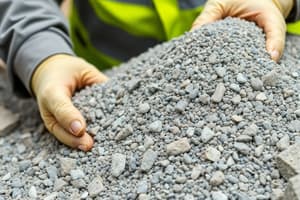Podcast
Questions and Answers
A material's ability to withstand impact loading without fracturing is best described by which property?
A material's ability to withstand impact loading without fracturing is best described by which property?
- Toughness (correct)
- Hardness
- Permeability
- Resilience
Abrasion resistance is quantified through which measurement process?
Abrasion resistance is quantified through which measurement process?
- Measuring the volume of fluid passing through a material
- Measuring the material's ability to store energy
- Measuring the depth of penetration of an object
- Measuring the amount of material removed by rubbing (correct)
A construction material that needs to efficiently transfer heat should have a high:
A construction material that needs to efficiently transfer heat should have a high:
- Permeability
- Chemical reactivity
- Coefficient of thermal conductivity (correct)
- Salvage value
What material property is most relevant when considering how well a material resists the passage of fluids?
What material property is most relevant when considering how well a material resists the passage of fluids?
Why is a material's chemical composition important when considering its environmental requirements?
Why is a material's chemical composition important when considering its environmental requirements?
When evaluating the economic viability of different construction materials, which factor relates to the material's worth at the end of its useful life?
When evaluating the economic viability of different construction materials, which factor relates to the material's worth at the end of its useful life?
A construction firm is evaluating materials for a bridge project in a region known for strong winds. Which material property should be prioritized to ensure the bridge's long-term stability?
A construction firm is evaluating materials for a bridge project in a region known for strong winds. Which material property should be prioritized to ensure the bridge's long-term stability?
An engineer is tasked with selecting a construction material for a high-rise building in an earthquake-prone area. Besides compressive strength, which material property is most crucial to consider for structural integrity?
An engineer is tasked with selecting a construction material for a high-rise building in an earthquake-prone area. Besides compressive strength, which material property is most crucial to consider for structural integrity?
Which of the following considerations falls under 'Economy' when choosing a construction material?
Which of the following considerations falls under 'Economy' when choosing a construction material?
A construction company is deciding between using traditional concrete and a newly developed composite material for a tunnel lining project. What is the MOST important reason for the company to perform rigorous material testing?
A construction company is deciding between using traditional concrete and a newly developed composite material for a tunnel lining project. What is the MOST important reason for the company to perform rigorous material testing?
Classifying civil engineering materials based on their phases primarily involves grouping them according to their:
Classifying civil engineering materials based on their phases primarily involves grouping them according to their:
During the selection of construction materials, naturally occurring materials are taken into consideration because of...
During the selection of construction materials, naturally occurring materials are taken into consideration because of...
A structural engineer is evaluating different types of steel for a bridge that will experience heavy and continuous traffic. Which aspect of material testing is MOST relevant to ensure the bridge will withstand the expected loads over its design life?
A structural engineer is evaluating different types of steel for a bridge that will experience heavy and continuous traffic. Which aspect of material testing is MOST relevant to ensure the bridge will withstand the expected loads over its design life?
Which of the following construction materials is classified as a semi-solid?
Which of the following construction materials is classified as a semi-solid?
Which of the following groups of gases are commonly considered in the context of civil engineering materials??
Which of the following groups of gases are commonly considered in the context of civil engineering materials??
If a construction project requires a non-ferrous metal with high conductivity, which material would be the MOST suitable?
If a construction project requires a non-ferrous metal with high conductivity, which material would be the MOST suitable?
A structural engineer is designing a bridge and needs to select a material that can withstand high tensile stresses. Which of the following materials would be the MOST appropriate choice?
A structural engineer is designing a bridge and needs to select a material that can withstand high tensile stresses. Which of the following materials would be the MOST appropriate choice?
Which category of materials is characterized by long chains of molecules composed of carbon, hydrogen, oxygen, and nitrogen, held together by covalent bonds or Van der Waals forces?
Which category of materials is characterized by long chains of molecules composed of carbon, hydrogen, oxygen, and nitrogen, held together by covalent bonds or Van der Waals forces?
Which of the following materials is classified under ceramics and is commonly used for structural applications such as walls and pavements?
Which of the following materials is classified under ceramics and is commonly used for structural applications such as walls and pavements?
In the context of material classification, which of the following determines whether a material like steel is categorized as 'ferrous'?
In the context of material classification, which of the following determines whether a material like steel is categorized as 'ferrous'?
Flashcards
Construction Material
Construction Material
Any substance used in building or construction projects.
Types of Construction Materials
Types of Construction Materials
Materials from nature (stone, sand) or manufacturing (cement, rebar).
Materials Testing
Materials Testing
Testing materials to gather information about their properties and suitability.
Importance of Material Testing
Importance of Material Testing
Signup and view all the flashcards
Creep Strength
Creep Strength
Signup and view all the flashcards
Gases
Gases
Signup and view all the flashcards
Liquids
Liquids
Signup and view all the flashcards
Semi-solids
Semi-solids
Signup and view all the flashcards
Solids
Solids
Signup and view all the flashcards
Ferrous Materials
Ferrous Materials
Signup and view all the flashcards
Non-Ferrous Materials
Non-Ferrous Materials
Signup and view all the flashcards
Polymers
Polymers
Signup and view all the flashcards
Toughness
Toughness
Signup and view all the flashcards
Resilience
Resilience
Signup and view all the flashcards
Hardness
Hardness
Signup and view all the flashcards
Abrasion resistance
Abrasion resistance
Signup and view all the flashcards
Thermal conductivity
Thermal conductivity
Signup and view all the flashcards
Permeability
Permeability
Signup and view all the flashcards
Chemical reaction
Chemical reaction
Signup and view all the flashcards
Initial cost
Initial cost
Signup and view all the flashcards
Study Notes
- Construction materials are any materials used for construction.
- The success of construction lies significantly on the materials, as it is important to test them against time.
- Durability is a relevant factor.
Types of Construction Materials
- Manufactured products include cement, pipes, ceramics, rebars, tiles, glass, and paints.
- Naturally occurring materials include stone, timber, sand, and soil.
Materials Testing
- Materials testing is performed for various reasons and provides information about tested materials, prototypes, or product samples.
- The data collected and the final test results are useful to engineers, designers, and production managers.
Reasons for Materials Testing
- Meeting requirements of regulatory agencies.
- Selecting appropriate materials and treatments for an application.
- Evaluating product design or improvement specifications.
- Verifying a production process.
Factors Determining Material Choice
- Strength, Rigidity, & Durability Requirements are key in material selection.
- Permanent loading relates to Creep Strength, which is the maximum stress a material can endure over time without extreme deformation.
- Repeated loading relates to Fatigue Strength, which is the highest stress a material can withstand for a given number of cycles without breaking.
- Impact loading relates to Toughness, which is the property allowing a material to withstand impact loading without fracture.
- Resilience enables a material to store energy without permanent deformation, which is also related to impact loading.
- Surface loading relates to Hardness, measured by depth of penetration, and Resistance to abrasion, measuring material removed by rubbing.
- Environmental Requirements also determine material choice.
- Temperature changes relate to the coefficient of thermal conductivity, a measure of a material's ability to conduct heat.
- Moisture movement relates to permeability, defined as the volume of fluid passing through a unit cross-section of a medium in unit time under a pressure gradient.
- Chemical effects relate to chemical composition, where reactants are converted into products.
- Economy is important, it is best to choose cheaper and available materials.
- When considering economy, one must look at initial costs
- Additionally, the material's useful life
- Important to keep in mind frequency of maintenance required
- Cost of maintenance needs to be within budget
- Salvage value is important to keep in mind when costing materials
- Comfortability of the material being used
Classification of Civil Engineering Materials
- According to their phases
- According to their internal structure & chemical composition
According to Phases
- Gases like Air, Oxygen, and CO2
- Liquids like Water and Chemical Admixtures
- Semi-solids such as Fresh pastes, mortars, and asphalt
- Solids like Metals and Hardened concrete
According to Internal Structure & Chemical Composition
- Metals such as Ferrous, including iron, cast iron and steel and Non-Ferrous, including aluminum, copper, zinc, and lead
- Polymers, which are long chains having molecules of C, H, O, N formed by covalent bonding.
- They can be natural, such as rubber, asphalt, resins, wood, or artificial, such as plastic.
- Ceramics are mainly aluminosilicates formed by mixed bonding and can be structural clay products, such as bricks, tiles, and pipes, or porcelains
- Composite Materials include Natural like agglomerates, and Artificial, such as Portland cement and concrete.
- Reinforced Composite Materials include reinforced concrete and reinforced plastics
Determining Material Properties
- Laboratory Testing.
- Field Testing.
Standardization Institutes
- U.S.: American Society for Testing and Materials (ASTM), American Association of State Highways and Transportation Officials (AASHTO), and American Concrete Institute (ACI).
- Turkey: Turkish Standards Institute (TSE).
- Europe: European Committee for Standardization (CEN).
- Germany: Deutsche Institute Norm (DIN).
- England: British Standards Institute (BSI).
Studying That Suits You
Use AI to generate personalized quizzes and flashcards to suit your learning preferences.
Related Documents
Description
Overview of construction materials, including manufactured products, naturally occurring substances, and the importance of materials testing. Materials testing is performed for various reasons and provides information about tested materials. Factors such as strength, rigidity, and durability are crucial in determining material choice.



